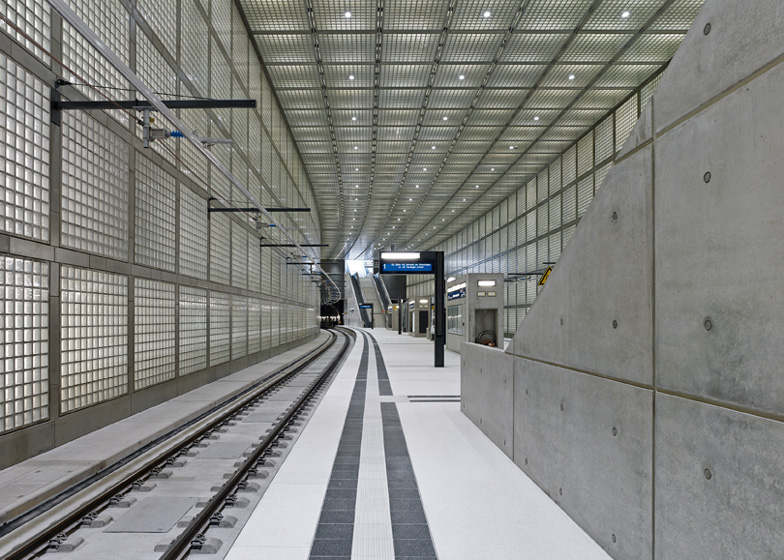This new metro station in Leipzig, Germany, by Swiss architect Max Dudler comprises a 140 metre-long tunnel made up of illuminated glass blocks.
The Wilhelm-Leuschner-Platz S-Bahn station is one of four stops along the new Leipzig City Tunnel railway line that has been under construction for over ten years and is set to open next month, creating a new link between some of the city's major stations.
Swiss architect Max Dudler, whose previous projects include a glowing library and a castle visitor centre, won a competition to design the station in 1997 with his proposal for a glowing tunnel with a gently curved concourse and raw concrete details.
Back-lit glass blocks are arranged in groups within a concrete framework to create large glowing squares across the entire length of the walls and ceiling.
"The seemingly endless repetition of the same element in the course of the slightly curved, light-filled hall increases the sensation of the dimensions of this already large structure," said the studio.
The station platform is covered in pale terrazzo and interspersed with concrete volumes that form seating areas and signage boards.
"All station furnishings of the station are arranged as geometric concrete sculptures," added the studio.
Entrances are positioned at the north and south ends of the platform, where solid concrete staircases are sandwiched between escalators. At street level, these entrances are contained within rectilinear structures that were also constructed using glass blocks.
Photography is by Stefan Müller.
Here's a project description from the design team:
Wilhelm-Leuschner-Platz Station
S-Bahn trains will cross beneath the centre of Leipzig from December 2013. This is when the 5.3 kilometre long city tunnel Leipzig, a joint development of Deutsche Bahn AG and the Free State of Saxony, will be completed. Wilhelm-Leuschner-Platz / Platz der Friedlichen revolution station on the southern end of the historic city centre is one of four stations of the major project that is currently one of the largest inner-city infrastructure projects in Europe.
The design of the station is based on architect Max Dudler's successful competition entry from 1997. The Swiss architect's impressive 140 metre long and 20 metre wide station concourse has just recently been awarded the city of Leipzig's architecture award.
The station concourse, with a rectangular section and a slight longitudinal curve, is situated 20 metres below ground. Walls and ceilings of the elongated, column-free hall are clad with large, backlit prefabricated glass blocks set into a framework of fair-faced precast concrete. This gives the station concourse a bright and spacious feel. Extreme repetition of one and the same motif makes its actual dimensions almost intangible for passengers.
The light-coloured, jointless terrazzo flooring of the insular platform acts as a quiet counterpoint to the seemingly endless pattern of the walls. All necessary station furniture is arranged on the platform in the shape of geometrical concrete sculptures, all functions such as seating, timetables and ticket machines having in a sense been subtracted from or carved out of the concrete cubes.
The station concourse's supporting structure of precast reinforced concrete is not visible behind the glass block cladding. The wall elements of the glass block envelope are anchored to a steel substructure on the tunnel wall. The ceiling elements are suspended from the building shell.
Passengers access the station through the entrances on the north and south ends of the station that are fitted with solid staircases, escalators and elevators. The architectural design of the two entrances is in deliberate contrast to the filigree, seemingly transparent station concourse. As soon as they dip beneath the surface of the square, the staircases and their inner casings are made entirely of fair-faced concrete. The minimalist, almost coarse design conveys an impression of descending towards the interior of the earth, as if it was tunnelled directly into the rock.
The stairs and the platform combine seamlessly into a monolithic ribbon. Similar to the station concourse, the aboveground entrance buildings have also been fitted with glass block components. They will help bring the square to life when illuminated at night.
Wilhelm Leuschner was a social democrat politician and part of the resistance against National Socialism. Formerly known as Königsplatz, this square in Leipzig was renamed Wilhelm-Leuschner-Platz in his honour in 1945. In 2013 it was finally renamed "Platz der Friedlichen Revolution" to honour the important role it played during German reunification.

